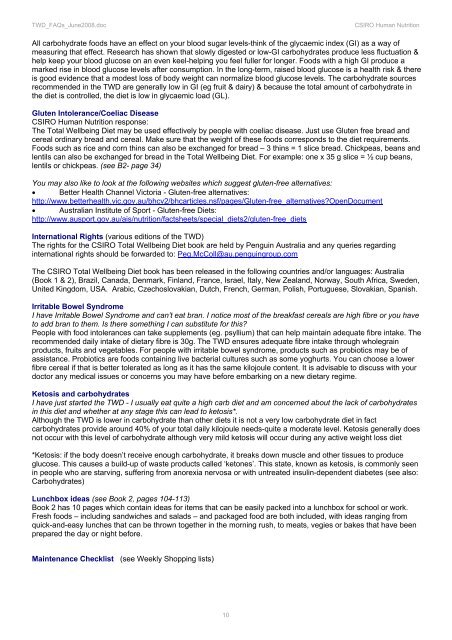The CSIRO Total Wellbeing Diet Frequently Asked Questions
The CSIRO Total Wellbeing Diet Frequently Asked Questions
The CSIRO Total Wellbeing Diet Frequently Asked Questions
You also want an ePaper? Increase the reach of your titles
YUMPU automatically turns print PDFs into web optimized ePapers that Google loves.
TWD_FAQs_June2008.doc <strong>CSIRO</strong> Human Nutrition<br />
All carbohydrate foods have an effect on your blood sugar levels-think of the glycaemic index (GI) as a way of<br />
measuring that effect. Research has shown that slowly digested or low-GI carbohydrates produce less fluctuation &<br />
help keep your blood glucose on an even keel-helping you feel fuller for longer. Foods with a high GI produce a<br />
marked rise in blood glucose levels after consumption. In the long-term, raised blood glucose is a health risk & there<br />
is good evidence that a modest loss of body weight can normalize blood glucose levels. <strong>The</strong> carbohydrate sources<br />
recommended in the TWD are generally low in GI (eg fruit & dairy) & because the total amount of carbohydrate in<br />
the diet is controlled, the diet is low in glycaemic load (GL).<br />
Gluten Intolerance/Coeliac Disease<br />
<strong>CSIRO</strong> Human Nutrition response:<br />
<strong>The</strong> <strong>Total</strong> <strong>Wellbeing</strong> <strong>Diet</strong> may be used effectively by people with coeliac disease. Just use Gluten free bread and<br />
cereal ordinary bread and cereal. Make sure that the weight of these foods corresponds to the diet requirements.<br />
Foods such as rice and corn thins can also be exchanged for bread – 3 thins = 1 slice bread. Chickpeas, beans and<br />
lentils can also be exchanged for bread in the <strong>Total</strong> <strong>Wellbeing</strong> <strong>Diet</strong>. For example: one x 35 g slice = ½ cup beans,<br />
lentils or chickpeas. (see B2- page 34)<br />
You may also like to look at the following websites which suggest gluten-free alternatives:<br />
• Better Health Channel Victoria - Gluten-free alternatives:<br />
http://www.betterhealth.vic.gov.au/bhcv2/bhcarticles.nsf/pages/Gluten-free_alternatives?OpenDocument<br />
• Australian Institute of Sport - Gluten-free <strong>Diet</strong>s:<br />
http://www.ausport.gov.au/ais/nutrition/factsheets/special_diets2/gluten-free_diets<br />
International Rights (various editions of the TWD)<br />
<strong>The</strong> rights for the <strong>CSIRO</strong> <strong>Total</strong> <strong>Wellbeing</strong> <strong>Diet</strong> book are held by Penguin Australia and any queries regarding<br />
international rights should be forwarded to: Peg.McColl@au.penguingroup.com<br />
<strong>The</strong> <strong>CSIRO</strong> <strong>Total</strong> <strong>Wellbeing</strong> <strong>Diet</strong> book has been released in the following countries and/or languages: Australia<br />
(Book 1 & 2), Brazil, Canada, Denmark, Finland, France, Israel, Italy, New Zealand, Norway, South Africa, Sweden,<br />
United Kingdom, USA. Arabic, Czechoslovakian, Dutch, French, German, Polish, Portuguese, Slovakian, Spanish.<br />
Irritable Bowel Syndrome<br />
I have Irritable Bowel Syndrome and can’t eat bran. I notice most of the breakfast cereals are high fibre or you have<br />
to add bran to them. Is there something I can substitute for this?<br />
People with food intolerances can take supplements (eg. psyllium) that can help maintain adequate fibre intake. <strong>The</strong><br />
recommended daily intake of dietary fibre is 30g. <strong>The</strong> TWD ensures adequate fibre intake through wholegrain<br />
products, fruits and vegetables. For people with irritable bowel syndrome, products such as probiotics may be of<br />
assistance. Probiotics are foods containing live bacterial cultures such as some yoghurts. You can choose a lower<br />
fibre cereal if that is better tolerated as long as it has the same kilojoule content. It is advisable to discuss with your<br />
doctor any medical issues or concerns you may have before embarking on a new dietary regime.<br />
Ketosis and carbohydrates<br />
I have just started the TWD - I usually eat quite a high carb diet and am concerned about the lack of carbohydrates<br />
in this diet and whether at any stage this can lead to ketosis*.<br />
Although the TWD is lower in carbohydrate than other diets it is not a very low carbohydrate diet in fact<br />
carbohydrates provide around 40% of your total daily kilojoule needs-quite a moderate level. Ketosis generally does<br />
not occur with this level of carbohydrate although very mild ketosis will occur during any active weight loss diet<br />
*Ketosis: if the body doesn’t receive enough carbohydrate, it breaks down muscle and other tissues to produce<br />
glucose. This causes a build-up of waste products called ‘ketones’. This state, known as ketosis, is commonly seen<br />
in people who are starving, suffering from anorexia nervosa or with untreated insulin-dependent diabetes (see also:<br />
Carbohydrates)<br />
Lunchbox ideas (see Book 2, pages 104-113)<br />
Book 2 has 10 pages which contain ideas for items that can be easily packed into a lunchbox for school or work.<br />
Fresh foods – including sandwiches and salads – and packaged food are both included, with ideas ranging from<br />
quick-and-easy lunches that can be thrown together in the morning rush, to meats, vegies or bakes that have been<br />
prepared the day or night before.<br />
Maintenance Checklist (see Weekly Shopping lists)<br />
10
















